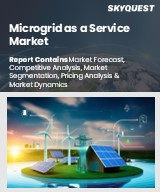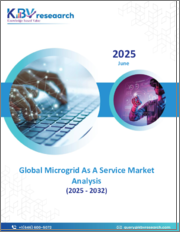
|
시장보고서
상품코드
1772318
미국의 MaaS(Microgrid as a Service) 시장 규모, 점유율, 동향 분석 리포트 : 그리드 유형별, 서비스 유형별, 부문별 예측(2025-2030년)U.S. Microgrid As A Service Market Size, Share & Trends Analysis Report By Grid Type (Grid Connected, Islanded), By Service Type (Software As A Service, Monitoring & Control, Operation & Maintenance), And Segment Forecasts, 2025 - 2030 |
||||||
미국의 MaaS(Microgrid as a Service) 시장 동향 :
미국의 MaaS(Microgrid as a Service) 시장 규모는 2024년에 9억 5,320만 달러에 달하며, 2025-2030년에 CAGR 12.0%로 성장할 것으로 예측됩니다.
시장 성장의 원동력은 재생에너지 통합에 대한 수요 증가, 강력한 전력 인프라에 대한 요구, 정부의 지원 정책 및 인센티브 등이며, 서비스형 마이크로그리드(MaaS, Microgrid as a Service)는 마이크로그리드의 설계, 설치, 운영, 유지보수를 포함한 턴키 솔루션입니다. 턴키 솔루션으로, 설비투자를 선행하지 않고도 에너지의 신뢰성과 복원력을 제공합니다. 주로 산업, 상업, 군, 교육기관 등의 분야에서 도입되고 있습니다. 이 모델은 탈탄소화 목표를 지원하고, 그리드 독립성을 높이고, 에너지 비용의 예측 가능성을 향상시킵니다.
2023년 1월, 알파스트럭처는 존 F. 케네디 국제공항의 마이크로그리드 인프라 건설, 설계 및 운영에 대한 계약을 발표했으며, 뉴 터미널 원(New Terminal One, NTO)의 마이크로그리드 인프라는 탄력적이고 지속가능하며, 비용 예측이 가능한 현지에서 생산된 에너지를 공급할 것입니다.
에너지 인프라 분야에서 서비스형 마이크로그리드(MaaS, Microgrid as a Service)는 병원, 군기지, 대학, 데이터센터와 같은 중요 시설에 안정적이고 효율적이며 탄력적인 전력 솔루션을 제공하는 데 필수적인 요소로 자리 잡고 있습니다. 정전이나 피크 수요시 메인 그리드에서 독립적으로 운영할 수 있도록 하여 지속적인 운영과 에너지 보안을 보장합니다. 설계부터 설치, 자금조달, 유지보수까지 모두 포함하는 턴키 모델은 초기 투자비용을 없애고, 첨단 에너지 시스템을 보다 쉽게 접근할 수 있도록 합니다. 기후 변화에 대한 대응력, 노후화된 그리드 인프라, 무정전 전력에 대한 수요 증가는 공공 및 민간 부문 모두에서 MaaS의 보급을 촉진하고 있습니다.
상업 및 산업 환경에서 MaaS는 태양광, 풍력, 축전지와 같은 재생에너지를 통합하여 탈탄소화 목표를 지원합니다. 이를 통해 기업은 에너지 사용을 최적화하고 온실 가스 배출을 줄이며 기업의 지속가능성 목표를 달성할 수 있으며, MaaS 시스템은 피크 절감, 수요 대응, 부하 최적화를 통해 에너지 비용을 관리할 수 있습니다. 이 모델은 예측 가능한 장기 운영 비용을 제공하여 기업이 자본 집약적 모델에서 서비스 기반 에너지 전략으로 전환할 수 있도록 지원합니다.
마이크로그리드는 기존의 전력망 확장이 현실적이지 않고, 서비스가 제공되지 않는 지역과 외딴 지역에서도 채택되고 있으며, MaaS 프로바이더는 경제 발전을 지원하고 삶의 질을 향상시키는 확장 가능한 지역 밀착형 전력 시스템을 제공합니다. 디지털 에너지 관리 플랫폼, AI 기반 제어 시스템, 배터리 효율성 향상과 같은 기술 발전으로 인해 MaaS 도입이 가속화되고 있으며, 보다 적응력 있고 데이터베이스이 강화되고 있습니다.
목차
제1장 조사 방법과 범위
제2장 개요
제3장 미국의 MaaS(Microgrid as a Service) 시장 변수, 동향, 범위
- 시장 계통 전망
- 모시장 전망
- 관련 시장 전망
- 업계 밸류체인 분석
- 규제 프레임워크
- 시장 역학
- 시장 성장 촉진요인 분석
- 시장 성장 억제요인 분석
- 업계의 과제
- 업계의 기회
- 업계 분석 툴
- Porter's Five Forces 분석
- 거시환경 분석
제4장 미국의 MaaS(Microgrid as a Service) 시장 : 그리드 유형별 추정·동향 분석
- 부문 대시보드
- 미국의 MaaS(Microgrid as a Service) 시장 : 그리드 유형별 변동 분석과 시장 점유율, 2024년·2030년
- 아일랜드
- 그리드 접속
제5장 미국의 MaaS(Microgrid as a Service) 시장 : 서비스 유형별 추정·동향 분석
- 부문 대시보드
- 미국의 MaaS(Microgrid as a Service) 시장 : 서비스 유형별 변동 분석과 시장 점유율, 2024년·2030년
- SaaS(Software as a Service)
- 모니터링·제어 서비스
- 운영·유지보수 서비스
제6장 미국의 MaaS(Microgrid as a Service) 시장 : 경쟁 구도
- 주요 시장 참여 기업에 의한 최근 동향과 영향 분석
- 기업 분류
- 기업 히트맵
- Position Analysis, 2024
- 전략 지도제작
- 확대
- 합병과 인수
- 파트너십과 협업
- 기업 개요
- ABB Ltd.
- Aggreko
- AlphaStruxure
- Ameresco
- Anbaric Development Partners, LLC.
- Eaton
- General Electric Company
- Parento Energy
- PowerSecure, Inc.
- Schneider Electric
- Siemens
- Spirae, LLC
U.S. Microgrid As A Service Market Trends:
The U.S. microgrid as a service market size was valued at USD 953.2 million in 2024 and is projected to grow at a CAGR of 12.0% from 2025 to 2030. The market growth is being driven by increasing demand for renewable energy integration, the need for resilient power infrastructure, and supportive government policies and incentives. Microgrid as a service is a turnkey solution that includes design, installation, operation, and maintenance of microgrids, providing energy reliability and resilience without the need for upfront capital investment. It is primarily deployed across sectors such as industrial, commercial, military, and educational institutions. This model supports decarbonization goals, enhances grid independence, and improves energy cost predictability.
In January 2023, AlphaStruxure announced an agreement to construct, design, and operate microgrid infrastructure at the John F. Kennedy International Airport. The microgrid infrastructure at New Terminal One (NTO) will provide resilient, sustainable, cost-predictable, and locally generated energy.
In the energy infrastructure sector, microgrid as a service (MaaS) has become essential for delivering reliable, efficient, and resilient power solutions, especially for critical facilities such as hospitals, military bases, universities, and data centers. MaaS enables these institutions to operate independently from the main grid during outages or peak demand, ensuring continuous operation and energy security. Its turnkey model-covering design, installation, financing, and maintenance-eliminates upfront capital requirements, making advanced energy systems more accessible. Rising concerns over climate resilience, aging grid infrastructure, and increasing demand for uninterrupted power drive widespread MaaS adoption in both public and private sectors.
In commercial and industrial settings, MaaS supports decarbonization goals by integrating renewable energy sources such as solar, wind, and battery storage. It allows companies to optimize energy use, reduce greenhouse gas emissions, and meet corporate sustainability targets. MaaS systems also manage energy costs through peak shaving, demand response, and load optimization. The model offers predictable long-term operating expenses, enabling businesses to shift from a capital-intensive model to a service-based energy strategy.
Microgrids are also being adopted in underserved or remote communities, where traditional grid expansion is impractical. MaaS providers offer scalable, localized power systems that support economic development and improve quality of life. Technological advancements in digital energy management platforms, AI-based control systems, and battery efficiency are accelerating MaaS deployment, making it more adaptive and data-driven.
U.S. Microgrid As A Service Market Report Segmentation
This report forecasts revenue growth at U.S. level and provides an analysis of the latest industry trends in each of the sub-segments from 2018 to 2030. For this study, Grand View Research has segmented the U.S. microgrid as a service industry report based on grid type and service type.
- Grid Type Outlook (Revenue, USD Million, 2018 - 2030)
- Islanded
- Grid Connected
- Service Type Outlook (Revenue, USD Million, 2018 - 2030)
- Software as a Service
- Monitoring & Control Service
- Operation & Maintain Service
Table of Contents
Chapter 1. Methodology and Scope
- 1.1. Market Segmentation & Scope
- 1.2. Market Definition
- 1.3. Information Procurement
- 1.3.1. Purchased Database
- 1.3.2. GVR's Internal Database
- 1.3.3. Secondary Raw Materials & Third-Party Perspectives
- 1.3.4. Primary Research
- 1.4. Information Analysis
- 1.4.1. Data Analysis Models
- 1.5. Market Formulation & Data Visualization
- 1.6. Data Validation & Publishing
Chapter 2. Executive Summary
- 2.1. Market Snapshot
- 2.2. Segment Snapshot
- 2.3. Competitive Landscape Snapshot
Chapter 3. U.S. Microgrid as a Service Market Variables, Trends & Scope
- 3.1. Market Lineage Outlook
- 3.1.1. Parent Market Outlook
- 3.1.2. Related Market Outlook
- 3.2. Industry Value Chain Analysis
- 3.3. Regulatory Framework
- 3.4. Market Dynamics
- 3.4.1. Market Driver Analysis
- 3.4.2. Market Restraint Analysis
- 3.4.3. Industry Challenges
- 3.4.4. Industry Opportunities
- 3.5. Industry Analysis Tools
- 3.5.1. Porter's Five Forces Analysis
- 3.5.2. Macro-environmental Analysis
Chapter 4. U.S. Microgrid as a Service Market: Grid Type Estimates & Trend Analysis
- 4.1. Segment Dashboard
- 4.2. U.S. Microgrid as a Service Market: Grid Type Movement Analysis & Market Share, 2024 & 2030
- 4.3. Islanded
- 4.3.1. Islanded Market Revenue Estimates and Forecasts, 2018 - 2030 (USD Million)
- 4.4. Grid Connected
- 4.4.1. Grid Connected Market Revenue Estimates and Forecasts, 2018 - 2030 (USD Million)
Chapter 5. U.S. Microgrid as a Service Market: Service Type Estimates & Trend Analysis
- 5.1. Segment Dashboard
- 5.2. U.S. Microgrid as a Service Market: Service Type Movement Analysis & Market Share, 2024 & 2030
- 5.3. Software as a Service
- 5.3.1. Software as a Service Market Revenue Estimates and Forecasts, 2018 - 2030 (USD Million)
- 5.4. Monitoring & Control Service
- 5.4.1. Monitoring & Control Service Market Revenue Estimates and Forecasts, 2018 - 2030 (USD Million)
- 5.5. Operation & Maintenance Service
- 5.5.1. Operation & Maintenance Service Market Revenue Estimates and Forecasts, 2018 - 2030 (USD Million)
Chapter 6. U.S. Microgrid as a Service Market - Competitive Landscape
- 6.1. Recent Developments & Impact Analysis, By Key Market Participants
- 6.2. Company Categorization
- 6.3. Company Heat Map
- 6.4. Position Analysis, 2024
- 6.5. Strategy Mapping
- 6.5.1. Expansion
- 6.5.2. Mergers & Acquisition
- 6.5.3. Partnerships & Collaborations
- 6.6. Company Profiles
- 6.6.1. ABB Ltd.
- 6.6.1.1. Participant's overview
- 6.6.1.2. Financial performance
- 6.6.1.3. Film Type benchmarking
- 6.6.1.4. Recent developments
- 6.6.2. Aggreko
- 6.6.2.1. Participant's overview
- 6.6.2.2. Financial performance
- 6.6.2.3. Film Type benchmarking
- 6.6.2.4. Recent developments
- 6.6.3. AlphaStruxure
- 6.6.3.1. Participant's overview
- 6.6.3.2. Financial performance
- 6.6.3.3. Film Type benchmarking
- 6.6.3.4. Recent developments
- 6.6.4. Ameresco
- 6.6.4.1. Participant's overview
- 6.6.4.2. Financial performance
- 6.6.4.3. Film Type benchmarking
- 6.6.4.4. Recent developments
- 6.6.5. Anbaric Development Partners, LLC.
- 6.6.5.1. Participant's overview
- 6.6.5.2. Financial performance
- 6.6.5.3. Film Type benchmarking
- 6.6.5.4. Recent developments
- 6.6.6. Eaton
- 6.6.6.1. Participant's overview
- 6.6.6.2. Financial performance
- 6.6.6.3. Film Type benchmarking
- 6.6.6.4. Recent developments
- 6.6.7. General Electric Company
- 6.6.7.1. Participant's overview
- 6.6.7.2. Financial performance
- 6.6.7.3. Film Type benchmarking
- 6.6.7.4. Recent developments
- 6.6.8. Parento Energy
- 6.6.8.1. Participant's overview
- 6.6.8.2. Financial performance
- 6.6.8.3. Film Type benchmarking
- 6.6.8.4. Recent developments
- 6.6.9. PowerSecure, Inc.
- 6.6.9.1. Participant's overview
- 6.6.9.2. Financial performance
- 6.6.9.3. Film Type benchmarking
- 6.6.9.4. Recent developments
- 6.6.10. Schneider Electric
- 6.6.10.1. Participant's overview
- 6.6.10.2. Financial performance
- 6.6.10.3. Film Type benchmarking
- 6.6.10.4. Recent developments
- 6.6.11. Siemens
- 6.6.11.1. Participant's overview
- 6.6.11.2. Financial performance
- 6.6.11.3. Film Type benchmarking
- 6.6.11.4. Recent developments
- 6.6.12. Spirae, LLC
- 6.6.12.1. Participant's overview
- 6.6.12.2. Financial performance
- 6.6.12.3. Film Type benchmarking
- 6.6.12.4. Recent developments
- 6.6.1. ABB Ltd.
(주말 및 공휴일 제외)


















